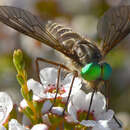pms
nòm ant ël fil


Tabanus australicus, commonly known as Australian common March fly, is a species of horse-fly in the family Tabanus.[2] It is endemic to Australia and found in the Queensland area.[3][4][5]
The species was first identified by Australian entomologist Frank Henry Taylor (1886–1945) in 1919. It was incorrectly identified as Tabanus queenslandii by Ferguson in 1920.
It is blackish-brown in colour, 13–15 mm (0.51–0.59 in) in length, with 10 mm (0.39 in) grey wings. The ocelli is rudimentary or absent, the antennal flagellum usually with a basal plate and 4-annulate. On the wings the basicosta are without setulate, and the proboscis is relatively stout with large labella.
Tabanus australicus, commonly known as Australian common March fly, is a species of horse-fly in the family Tabanus. It is endemic to Australia and found in the Queensland area.
The species was first identified by Australian entomologist Frank Henry Taylor (1886–1945) in 1919. It was incorrectly identified as Tabanus queenslandii by Ferguson in 1920.
It is blackish-brown in colour, 13–15 mm (0.51–0.59 in) in length, with 10 mm (0.39 in) grey wings. The ocelli is rudimentary or absent, the antennal flagellum usually with a basal plate and 4-annulate. On the wings the basicosta are without setulate, and the proboscis is relatively stout with large labella.
 Tabanus australicus
Tabanus australicus
Tabanus australicus adolah sabuah spesies Tabanidae. Spesies ko juo marupokan bagian dari ordo Diptera, kelas Insecta, filum Arthropoda, dan kingdom Animalia.
Lalek kudo dewasa mahisok nektar dan kadang-kadang sarbuak sari. Betino dari kabanyakan spesies adolah anautojenik, nan artinyo butuah mahisok darah sabalun mampu untuak bareproduksi sacaro efektif. Telua dilatakkan di ateh batu atau vegetasi biasonyo balansuang dakek jo aia misalnyo kolam ranang.
Tabanus australicus adolah sabuah spesies Tabanidae. Spesies ko juo marupokan bagian dari ordo Diptera, kelas Insecta, filum Arthropoda, dan kingdom Animalia.
Lalek kudo dewasa mahisok nektar dan kadang-kadang sarbuak sari. Betino dari kabanyakan spesies adolah anautojenik, nan artinyo butuah mahisok darah sabalun mampu untuak bareproduksi sacaro efektif. Telua dilatakkan di ateh batu atau vegetasi biasonyo balansuang dakek jo aia misalnyo kolam ranang.